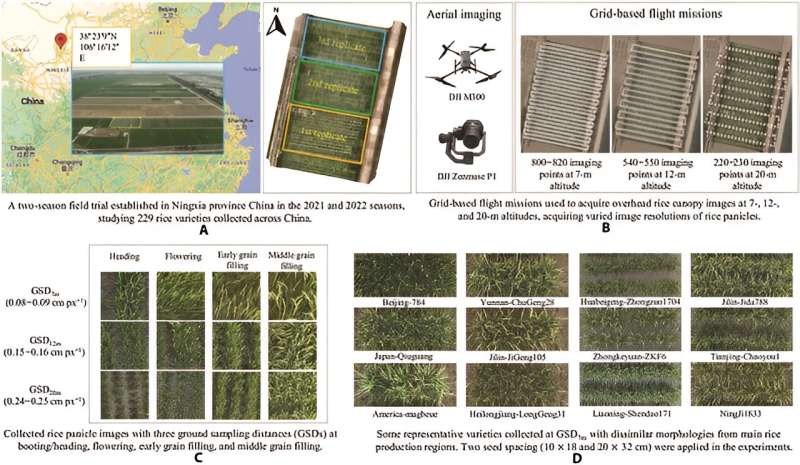This article has been reviewed according to Science X's editorial process and policies. Editors have highlighted the following attributes while ensuring the content's credibility:
fact-checked
proofread
An AI-driven approach to enhancing rice yield prediction and selection

Rice (Oryza sativa) is a staple food for many people, but rice production is challenged by climate change, making it critical to improve yield traits such as panicle number per unit area (PNpM2).
Recent research has focused on using computer vision and AI to quantify PNpM2, with methods such as deep learning proving effective in small-scale trials. However, these techniques face scalability challenges, diversity of rice varieties, and lack of large, high-quality training datasets. Overcoming these challenges is critical to developing robust, large-scale phenotypic analysis tools to improve rice production in a rapidly changing climate.
Plant Phenomics published a database/software article titled "Panicle-Cloud: An Open and AI-Powered Cloud Computing Platform for Quantifying Rice Panicles from Drone-Collected Imagery to Enable the Classification of Yield Production in Rice."
The research presents the Panicle-Cloud platform, a significant advancement in agricultural technology that provides an AI-powered cloud computing solution for quantifying rice panicles from drone-collected imagery. The project first developed an open expert-annotated diverse rice panicle detection (DRPD) dataset and then integrated several deep learning (DL) models into the platform.
Through an iterative improvement process, the Panicle AI model emerged as the preferred choice, demonstrating superior panicle detection accuracy. To determine optimal conditions for panicle phenotyping, drone flights at different altitudes and key growth stages were analyzed, and it was found that an altitude of 7m during early grain-filling stages provided the most accurate results.
Correlation analysis between Panicle-AI-derived scoring and manual counts confirmed the model's effectiveness, particularly at the 7m height, with a high correlation coefficient (R2 = 0.945). The Panicle-AI model outperformed 13 state-of-the-art DL models in panicle detection accuracy. The Panicle-Cloud platform was then designed to be user-friendly, allowing non-experts to select from different AI models for panicle detection using a simple web-based interface.
Users can process images individually or in batches, and the platform optimizes computation by cropping larger images.
The platform's ability to classify yield performance based on the PNpM2 trait was tested in a two-season rice field trial. Using a supervised machine learning model, specifically the CatBoost algorithm, the platform successfully classified rice yield production into low, medium, and high categories with an overall accuracy of 84.03%. This feature allows rice breeders to effectively screen and select preferred varieties based on predicted yield performance.
In conclusion, Panicle-Cloud demonstrates the potential of integrating AI, cloud computing, and drone technology to revolutionize rice breeding and cultivation. The platform improves the efficiency and accuracy of quantifying yield-related traits and makes advanced phenotyping tools more accessible to a wider range of users, thereby increasing the ability to select high-yielding varieties in the face of global food demand challenges.
More information: Zixuan Teng et al, Panicle-Cloud: An Open and AI-Powered Cloud Computing Platform for Quantifying Rice Panicles from Drone-Collected Imagery to Enable the Classification of Yield Production in Rice, Plant Phenomics (2023). DOI: 10.34133/plantphenomics.0105
Provided by Plant Phenomics





















